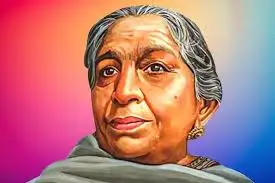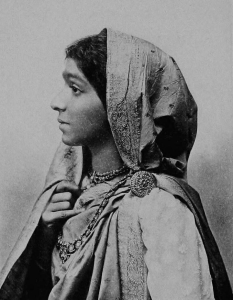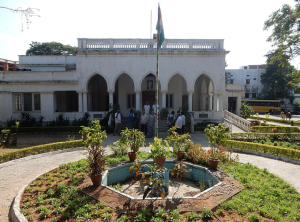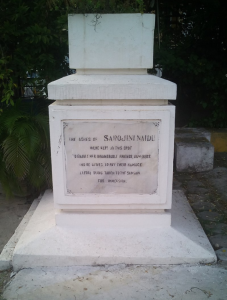Sarojini Naidu Biography, Images, Age, Height, Family, Religion, Career, Salary, Net Worth, and More

Sarojini Naidu: A Deep Dive into Her Biography, Images, Age, Height, Family, Religion, Career, Salary, Net Worth, and More
Sarojini Naidu, one of the most iconic figures in Indian history, made lasting contributions to literature, politics, and the fight for independence. Known as the “Nightingale of India,” her life was an amalgamation of literary brilliance, social activism, and an unwavering commitment to the cause of freedom. In this article, we will explore Sarojini Naidu’s biography, family, religion, career, net worth, and more, shedding light on the many facets of her extraordinary life.

1st Governor of the United Provinces
In office
15 August 1947 – 2 March 1949
Preceded by Position established
Succeeded by Hormasji Peroshaw Mody
44th President of the Indian National Congress
In office
1925–1926
Preceded by Mahatma Gandhi
Succeeded by S. Srinivasa Iyengar
Personal details
Born Sarojini Naidu
13 February 1879
Hyderabad, Hyderabad State, British Raj
(present-day Telangana, India)
Died 2 March 1949 (aged 70)
Lucknow, United Provinces, India
(present-day Uttar Pradesh, India)
Political party Indian National Congress
Spouse Govindarajulu Naidu (m. 1898)
Children 5, including Padmaja
Relatives
Virendranath (brother)Harindranath (brother)Suhasini (sister)
Alma mater
Cambridge University
Girton College, Cambridge
Occupation Political activist, Poet
Nicknames
“Nightingale of India”
“Bhārata Kōkiḷā”
“Bulbul-e-Hind”
Writing career
Language English
Genre Lyric poetry
Subject Indian nationalism
Notable works The Golden Threshold”In the Bazaars of Hyderabad
Sarojini Naidu Biography: The Early Years
Sarojini Naidu was born on February 13, 1879, in Hyderabad, India, to a well-educated and affluent family. Her father, Aghorenath Chattopadhyay, was a scientist and philosopher, and her mother, Barada Sundari Devi, was a poetess. Sarojini was a precocious child, showing early signs of literary talent. She began writing poems at a young age, and by the time she was 12, her works had already caught the attention of literary figures.

At the age of 16, she went to England to study at the prestigious King’s College London and later at Girton College, Cambridge. It was during these years that she honed her writing skills, which would later earn her international acclaim. Sarojini Naidu’s poetic genius was recognized early, and she went on to become one of India’s leading poets and an influential political figure.
Beginning in 1904, Naidu became an increasingly popular orator, promoting Indian independence and women’s rights, especially women’s education. Her oratory often framed arguments following the five-part rhetorical structures of Nyaya reasoning. She addressed the Indian National Congress and the Indian Social Conference in Calcutta in 1906. Her social work for flood relief earned her the Kaisar-i-Hind Medal in 1911, which she later returned in protest over the April 1919 Jallianwala Bagh massacre.[citation needed] She met Muthulakshmi Reddy in 1909, and in 1914 she met Mahatma Gandhi, whom she credited with inspiring a new commitment to political action. She was the first woman President of the Indian National Congress and first Indian woman to preside over the INC conference .
With Reddy, she helped established the Women’s Indian Association in 1917. Later that year, Naidu accompanied her colleague Annie Besant, who was the president of Home Rule League and Women’s Indian Association, to advocate universal suffrage in front of the Joint Select Committee in London, United Kingdom.She also supported the Lucknow Pact, a joint Hindu–Muslim demand for British political reform, at the Madras Special Provincial Council. As a public speaker, Naidu’s oratory was known for its personality and its incorporation of her poetry.
Sarojini Naidu Family and Personal Life
Sarojini Naidu was married to Govindarajulu Naidu, a doctor from a distinguished family, in 1898. Together, they had five children. Sarojini was known to balance her family responsibilities with her passion for writing and activism. Her personal life was one of dedication to her loved ones, as well as to the causes she believed in. Despite the challenges of balancing her home life and her public life, she emerged as a beacon of inspiration for women everywhere.
Her family played a significant role in her development, especially her father, who encouraged her to pursue her academic and literary ambitions. Sarojini’s deep connection with her family and her strong cultural roots were evident in both her poetry and her political work.
Sarojini Naidu was born in Hyderabad on 13 February 1879 to Aghorenath Chattopadhyay. Her father was from Brahmangaon, Bikrampur, Dhaka, Bengal (now in Bangladesh). Her father was a Bengali Hindu and the principal of Nizam College. He held a doctorate of Science from Edinburgh University. Her mother wrote poetry in Bengali.
She was the eldest of the eight siblings. Her brother Virendranath Chattopadhyay was a revolutionary, and another brother Harindranath was a poet, a dramatist, and an actor. Their family was well-regarded in Hyderabad.
Sarojini Naidu Age, Height, and Physical Appearance
Sarojini Naidu lived a life full of purpose and energy. She was born in 1879, and although she passed away in 1949 at the age of 70, her contributions continue to resonate today. Her height, as per historical records, was average for her time, and she was often described as a graceful woman, with an elegant and dignified presence.
While her physical appearance has been captured in various portraits and photographs, it is her literary and political legacy that truly defines her. Naidu’s impact went far beyond her appearance, touching the hearts and minds of generations of Indians.
Sarojini Naidu Religion: A Blend of Faiths
Sarojini Naidu was born into a Hindu family, but her progressive views on society and her exposure to Western education led her to embrace a more inclusive perspective. Though deeply rooted in Indian culture and values, she was open to various religious and philosophical ideas. Sarojini’s work often reflected her commitment to unity, social justice, and secularism, making her a symbol of harmony in a diverse nation like India.
Her approach to religion was one of inclusivity and respect for all faiths. She strongly believed in the idea of a united India, where people of all religions and backgrounds could live together peacefully and harmoniously.
Sarojini Naidu Career: From Poet to Politician
Sarojini Naidu’s career spanned both the realms of literature and politics, marking her as a multi-faceted individual who made significant contributions in each field. As a poet, her works often dealt with themes of patriotism, love, and the beauty of Indian culture. Her most famous poems include “In the Bazaars of Hyderabad,” “The Palanquin Bearers,” and “The Queen’s Rival.” Naidu’s lyrical writing was deeply influenced by her love for the Indian landscape, history, and people.
However, it was her political career that truly set her apart as a leader and freedom fighter. She was an active participant in the Indian independence movement and worked closely with leaders like Mahatma Gandhi and Jawaharlal Nehru. Sarojini Naidu was the first woman to become the president of the Indian National Congress, and she played a crucial role in organizing protests and raising awareness about India’s struggle for freedom.
In 1947, after India gained independence, Naidu was appointed as the Governor of the United Provinces (now Uttar Pradesh), making her the first woman to hold a gubernatorial position in independent India.
Naidu began writing at the age of 12. Her play, Maher Muneer, written in Persian, impressed the Nizam of Kingdom of Hyderabad.[citation needed]
Naidu’s poetry was written in English and usually took the form of lyric poetry in the tradition of British Romanticism, which she was sometimes challenged to reconcile with her Indian nationalist politics. She was known for her vivid use of rich sensory images in her writing, and for her lush depictions of India. She was well-regarded as a poet, considered the “Indian Yeats”.
Her first book of poems was published in London in 1905, titled “The Golden Threshold”. The publication was suggested by Edmund Gosse, and bore an introduction by Arthur Symons. It also included a sketch of Naidu as a teenager, in a ruffled white dress, drawn by John Butler Yeats. Her second and most strongly nationalist book of poems, The Bird of Time, was published in 1912. It was published in both London and New York, and includes “In the Bazaars of Hyderabad”. The last book of new poems published in her lifetime, The Broken Wing (1917). It includes the poem “The Gift of India”, which exhorted the Indian people to remember the sacrifices of the Indian Army during World War I, which she had previously recited to the Hyderabad Ladies’ War Relief Association in 1915. It also includes “Awake!”, dedicated to Muhammad Ali Jinnah, which she read as the conclusion to a 1915 speech to the Indian National Congress to urge unified Indian action. A collection of all her published poems was printed in New York in 1928. After her death, Naidu’s unpublished poems were collected in The Feather of the Dawn (1961), edited by her daughter Padmaja Naidu.
Sarojini Naidu Salary and Net Worth: A Glimpse into Her Financial Life
While detailed records of Sarojini Naidu’s salary and net worth are not widely available, it is important to note that her income primarily came from her literary works, public service, and activism. During her political career, she was not motivated by financial gain but by a desire to serve the people of India.
Naidu’s writings were well-respected and widely published, and she received many awards and honors during her lifetime. However, it is unlikely that her financial wealth was substantial by today’s standards. Her true worth, as many historians agree, lies in her immense contributions to literature and the Indian independence movement, which left an indelible mark on the nation.
Sarojini Naidu Images: Capturing the Legacy
The legacy of Sarojini Naidu has been immortalized in countless images, paintings, and photographs. Whether in her literary gatherings, political meetings, or personal moments with family, each image tells the story of a woman who was both graceful and formidable. Her photographs often depict her with a calm demeanor, wearing traditional Indian attire, with an aura of dignity and intelligence.
Naidu is known as “one of India’s feminist luminaries”. Naidu’s birthday, 13 February, is celebrated as Women’s Day to recognise powerful voices of women in India’s history.
Composer Helen Searles Westbrook (1889–1967) set Naidu’s text to music in her song “Invincible.”
As a poet, Naidu was known as the “Nightingale of India”. Edmund Gosse called her “the most accomplished living poet in India” in 1919.

Naidu is memorialized in the Golden Threshold, an off-campus annex of University of Hyderabad named for her first collection of poetry. Golden Threshold now houses the Sarojini Naidu School of Arts & Communication in the University of Hyderabad.
Asteroid 5647 Sarojininaidu, discovered by Eleanor Helin at Palomar Observatory in 1990, was named in her memory. The official naming citation was published by the Minor Planet Center on 27 August 2019 (M.P.C. 115893).
In 2014, Google India commemorated Naidu’s 135th birth anniversary with a Google Doodle.
Sarojini Naidu Death
Naidu died of cardiac arrest at 3:30 p.m. (IST) on 2 March 1949 at the Government House in Lucknow. Upon her return from New Delhi on 15 February, she was advised to rest by her doctors, and all official engagements were canceled. Her health deteriorated substantially and bloodletting was performed on the night of 1 March after she complained of severe [headache]. She collapsed following a fit of cough. Naidu was said to have asked the nurse attending to her to sing to her at about 10:40 p.m. (IST) which put her to sleep. She subsequently died, and her last rites were performed at the Gomati River

Conclusion: Sarojini Naidu’s Lasting Impact
Sarojini Naidu’s biography is one of triumph and tragedy, poetry and politics, love and sacrifice. As a poet, she painted vivid pictures of India’s culture and heritage. As a politician, she played a pivotal role in India’s quest for independence. And as a woman, she broke barriers, setting new standards for what women could achieve in a male-dominated society.
Her life is a testament to the power of education, activism, and self-belief. Sarojini Naidu’s legacy lives on, and she remains one of the most celebrated figures in Indian history, inspiring generations to come.
If you’re interested in learning more about Sarojini Naidu’s life and works, be sure to explore her poetry and writings, as well as her contributions to the freedom struggle. Sarojini Naidu’s biography is one of courage, beauty, and undying spirit.




